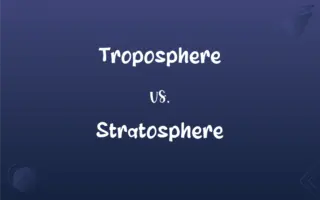Lycra vs. Neoprene: What's the Difference?
Edited by Aimie Carlson || By Janet White || Published on February 6, 2024
Lycra is a stretchy, lightweight fabric known for its elasticity, used in tight-fitting garments, whereas neoprene is a thick, insulating synthetic rubber used in wetsuits and protective gear.

Key Differences
Lycra, also known as spandex, is celebrated for its exceptional elasticity and is commonly used in athletic wear, swimwear, and form-fitting clothing. Neoprene, in contrast, is a type of synthetic rubber, known for its thermal insulation and water-resistant properties, making it ideal for wetsuits and protective covers.
The texture of Lycra is smooth and soft, providing comfort and a second-skin feel, which is essential in activewear and lingerie. Neoprene, on the other hand, has a more rubbery and dense texture, providing cushioning and durability, used in laptop sleeves and orthopedic braces.
Lycra's key feature is its ability to stretch up to six times its length and return to its original shape, making it perfect for garments that require freedom of movement. Neoprene, while also flexible, is more rigid and provides thermal insulation, suited for cold water diving suits and gear.
In terms of breathability, Lycra offers superior air circulation, which is vital for comfort in sports and daily wear. Neoprene's structure, however, is designed to trap heat, which is beneficial in cold environments but less breathable.
Lycra is often blended with other fabrics to enhance stretchability and comfort in clothing. Neoprene, being thicker and more protective, is used independently in products that require padding and insulation, like knee pads and cooler bags.
ADVERTISEMENT
Comparison Chart
Material Type
Elastic synthetic fiber
Synthetic rubber
Primary Use
Athletic wear, swimwear
Wetsuits, protective gear
Texture
Smooth, lightweight
Rubber-like, dense
Stretchability
High elasticity
Flexible but more rigid
Breathability
Highly breathable
Low breathability
ADVERTISEMENT
Lycra and Neoprene Definitions
Lycra
Lycra is also known as spandex, especially in North America.
The swimwear label reads Made with 100% Lycra/Spandex.
Neoprene
Neoprene is a synthetic rubber with thermal insulation properties.
The diver's suit is made of Neoprene to keep warm underwater.
Lycra
Lycra is used in garments that require close body fit.
Her dancewear is primarily made of Lycra for ease of movement.
Neoprene
Neoprene is used for protective gear due to its cushioning effect.
Her laptop bag is made of Neoprene for extra protection.
Lycra
Lycra is a popular material in sportswear due to its lightweight and flexible nature.
Cyclists prefer Lycra jerseys for their aerodynamic fit.
Neoprene
Neoprene's water resistance makes it ideal for aquatic sports equipment.
The kayak's seat cover is crafted from Neoprene for durability in water.
Lycra
Lycra is an elastic synthetic fiber known for its stretchability.
The yoga pants are made of Lycra for better flexibility.
Neoprene
Neoprene is often seen in orthopedic braces for support and comfort.
His knee brace is made from Neoprene to provide both support and flexibility.
Lycra
Lycra is often blended with other materials for stretchy, form-fitting clothing.
The Lycra blend in the fabric makes the shirt comfortably stretchy.
Neoprene
Neoprene is thicker and less breathable compared to fabrics like Lycra.
The Neoprene gloves are great for cold weather but not very breathable.
Neoprene
A synthetic rubber produced by polymerization of chloroprene and used in weather-resistant products, adhesives, shoe soles, sportswear, paints, and rocket fuels.
Neoprene
A synthetic rubber, a polymer of chloroprene, commonly used in wetsuits, laptop sleeves, orthopedic braces, electrical insulation, liquid and sheet-applied elastomeric membranes and flashings, car fan belts, etc.
Neoprene
A synthetic rubber that is resistant to oils and aging; used in waterproof products
FAQs
What is Lycra?
Lycra is a synthetic fiber known for its exceptional elasticity. It's a brand name for elastane.
Can Lycra be recycled?
Recycling Lycra is challenging due to its mixed composition, but some specialized processes do exist.
Is Lycra breathable?
Yes, Lycra is breathable, making it comfortable for active wear.
Can Lycra cause allergies?
Rarely, but some people may have a skin reaction to Lycra or the chemicals used in its production.
Does Lycra lose elasticity over time?
Yes, Lycra can lose its elasticity with wear and tear, especially if not cared for properly.
What are the main uses of Lycra?
Lycra is commonly used in clothing that requires stretch, like activewear, swimwear, and underwear.
What is Neoprene?
Neoprene is a synthetic rubber, known for its insulating properties and durability.
What are common uses of Neoprene?
It's used in wetsuits, laptop sleeves, orthopedic braces, and electrical insulation.
How to wash Lycra garments?
Wash in cold water with mild detergent and avoid high heat, as it can damage the fibers.
How is Lycra different from spandex?
Lycra is a brand name of spandex. There's no difference in the material itself.
Is Neoprene waterproof?
Neoprene itself is water-resistant, making it ideal for aquatic gear.
Can Neoprene cause skin irritation?
Some people may experience irritation, often due to quality or additives in the neoprene.
How is Neoprene made?
Neoprene is produced by polymerizing chloroprene, forming polychloroprene chips which are then melted and molded.
Is Neoprene eco-friendly?
Traditional neoprene isn't very eco-friendly due to its synthetic nature and production process. However, there are eco-friendlier versions made from limestone or recycled materials.
Is Lycra waterproof?
Lycra itself is not waterproof but is quick-drying.
Is Lycra eco-friendly?
Lycra is not particularly eco-friendly as it's a synthetic, petroleum-based fiber.
Is Neoprene breathable?
Neoprene is not naturally breathable, but perforated versions offer some air flow.
Can Neoprene be recycled?
Yes, but the process is complex. Some companies specialize in recycling neoprene products.
Does Neoprene degrade over time?
Yes, it can degrade, especially when exposed to environmental factors like UV light.
How to care for Neoprene products?
Hand wash with mild soap in cool water and air dry away from direct sunlight.
About Author
Written by
Janet WhiteJanet White has been an esteemed writer and blogger for Difference Wiki. Holding a Master's degree in Science and Medical Journalism from the prestigious Boston University, she has consistently demonstrated her expertise and passion for her field. When she's not immersed in her work, Janet relishes her time exercising, delving into a good book, and cherishing moments with friends and family.
Edited by
Aimie CarlsonAimie Carlson, holding a master's degree in English literature, is a fervent English language enthusiast. She lends her writing talents to Difference Wiki, a prominent website that specializes in comparisons, offering readers insightful analyses that both captivate and inform.






































































